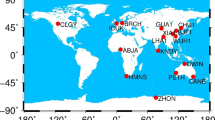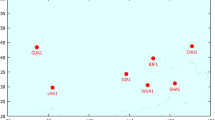Abstract
China is currently focusing on the establishment of its BDS-3 system, and a BDS-3 constellation with 18 satellites in medium Earth orbit (MEO) and one satellite in geostationary Earth orbit (GEO) has been able to provide preliminary global services since the end of 2018. These BDS-3 satellites feature the inter-satellite link (ISL) and new high-quality onboard clocks. In this study, we present the analysis of BDS-3 orbits and clocks determined by Ka-band ISL measurements from 18 MEO satellites and one GEO satellite. The ISL data of 43 days from 1 January to 12 February 2019 are used. The BDS-3 ISL measurement is described by a dual one-way ranging model. After converting bidirectional observations to the same epoch, Ka-band clock-free and geometry-free observables are obtained by the addition and subtraction of dual one-way observations, respectively. One anchor station with Ka-band bidirectional observations is introduced into the orbit determination to provide the orientation constraints. Using Ka-band clock-free observables, BDS-3 satellite orbits are determined. The ISL hardware delays are estimated together with orbits, and the resulting hardware delay estimates are quite stable with STD of about 0.03 ns. The Ka-band orbits are evaluated by orbit overlap differences, comparison with L-band precise orbits, and satellite laser ranging validation. The results indicate that the radial orbit errors are on the 2–4 cm level for MEO satellites and 8–10 cm for the GEO satellite. In addition, we investigate the ground anchoring capability by adding one anchor station and reducing the amount of data of the anchor station. Using Ka-band geometry-free observables, BDS-3 satellite clocks are estimated and the RMS of post-fit ISL residuals is about 5 cm. The Ka-band clock offsets are analyzed and compared with L-band precise clocks. Independent of orbit errors, the Allan deviation of Ka-band clocks for averaging interval longer than 5000 s is superior to that of L-band clocks. Furthermore, a pronounced bump, which appears in the Allan deviation of L-band clocks, almost vanishes in Ka-band clocks. Finally, the periodic variations are detected for L-band and Ka-band clocks.

















Similar content being viewed by others
Data availability
The ISL data used in this study are collected and managed by the BeiDou telemetry, track and command (TT&C) system, and can be available with the permission of the official department, i.e., China Satellite Navigation Office (CSNO).
References
Abusali P, Tapley B, Schutz B (1998) Autonomous navigation of global positioning system satellites using cross-link measurements. J Guid Control Dyn 21(2):321–327
Bizouard C, Lambert S, Becker O, Richard JY (2017) Combined solution C04 for Earth Rotation Parameters consistent with International Terrestrial Reference Frame 2014. http://hpiers.obspm.fr/eoppc/eop/eopc04/C04.guide.pdf. Accessed 20 June 2019
Boehm J, Niell A, Tregoning P, Schuh H (2006) Global mapping function (GMF): a new empirical mapping function based on numerical weather model data. Geophys Res Lett 33(7):L07304. https://doi.org/10.1029/2005GL025546
CSNO (2017) BeiDou navigation satellite system signal in space interface control document open service signal B1C and B2a (Version 1.0). China Satellite Navigation Office, December 2017. http://www.beidou.gov.cn/xt/gfxz/201712/P020171226741342013031.pdf. Accessed 20 June 2019
CSNO (2018) BeiDou navigation satellite system signal in space interface control document open service signal B3I (Version 1.0). China Satellite Navigation Office, February 2018. http://www.beidou.gov.cn/xt/gfxz/201802/P020180209623601401189.pdf. Accessed 20 June 2019
CSNO (2019) BeiDou navigation satellite system signal in space interface control document open service signal B1I (Version 3.0). China Satellite Navigation Office, February 2019. http://www.beidou.gov.cn/xt/gfxz/201902/P020190227593621142475.pdf. Accessed 20 June 2019
Fernández FA (2011) Inter-satellite ranging and inter-satellite communication links for enhancing GNSS satellite broadcast navigation data. Adv Space Res 47(5):786–801. https://doi.org/10.1016/j.asr.2010.10.002
Han C, Yang Y, Cai Z (2011) BeiDou navigation satellite system and its time scales. Metrologia 48(4):S213–S218. https://doi.org/10.1088/0026-1394/48/4/s13
Li X, Yuan Y, Zhu Y et al (2018) Precise orbit determination for BDS3 experimental satellites using iGMAS and MGEX tracking networks. J Geodesy 93(1):103–117. https://doi.org/10.1007/s00190-018-1144-0
Lin X, Lin B, Liu Y et al (2018) Satellite geometry and attitude mode of BDS-3 MEO satellites developed by SECM. In: Proceedings of the 31st international technical meeting of the satellite division of the institute of navigation (ION GNSS + 2018), Miami, Florida, September 2018, pp 1268–1289
Lv Y, Geng T, Zhao Q et al (2018) Characteristics of BeiDou-3 experimental satellite clocks. Remote Sens 10(11):1847. https://doi.org/10.3390/rs10111847
Lv Y, Geng T, Zhao Q et al (2019) Initial assessment of BDS-3 signal-in-space range errors. In: Geophysical Research abstracts, vol 21, EGU2019-12009-1, 2019
Maine K, Anderson P, Langer J (2003) Crosslinks for next generation GPS. In: Proceedings of 2003 aerospace conference IEEE proceedings, Big Sky, MT, USA, March 2003, pp 1589–1595. https://doi.org/10.1109/AERO.2003.1235087
Montenbruck O, Schmid R, Mercier F et al (2015) GNSS satellite geometry and attitude models. Adv Space Res 56(6):1015–1029. https://doi.org/10.1016/j.asr.2015.06.019
Montenbruck O, Steigenberger P, Prange L et al (2017) The multi-GNSS experiment (MGEX) of the international GNSS service (IGS)—achievements, prospects and challenges. Adv Space Res 59(7):1671–1697. https://doi.org/10.1016/j.asr.2017.01.011
Pan J, Hu X, Zhou S et al (2018) Time synchronization of new-generation BDS satellites using inter-satellite link measurements. Adv Space Res 61(1):145–153. https://doi.org/10.1016/j.asr.2017.10.004
Pearlman MR, Degnan JJ, Bosworth JM (2002) The international laser ranging service. Adv Space Res 30(2):135–143. https://doi.org/10.1016/S0273-1177(02)00277-6
Petit G, Luzum B (2010) IERS conventions 2010, Technical report. IERS Convention Center
Rajan JA (2002) Highlights of GPS II-R autonomous navigation. In: Proceedings of the 58th annual meeting of the institute of navigation and CIGTF 21st guidance test symposium, Institute of Navigation, Albuquerque, NM, June 2002, pp 354–363
Rajan JA, Brodie P, Rawicz H (2003) Modernizing GPS autonomous Navigation with anchor capability. In: Proceedings of ION GPS/GNSS 2003, Institute of Navigation, Portland, Oregon, September 2003, pp 1534–1542
Ren X, Yang Y, Zhu J et al (2017) Orbit determination of the next-generation Beidou satellites with intersatellite link measurements and a priori orbit constraints. Adv Space Res 60(10):2155–2165. https://doi.org/10.1016/j.asr.2017.08.024
Ren X, Yang Y, Zhu J et al (2019) Comparing satellite orbit determination by batch processing and extended Kalman filtering using inter-satellite link measurements of the next-generation BeiDou satellites. GPS Solut 23:25. https://doi.org/10.1007/s10291-018-0816-9
Senior KL, Ray JR, Beard RL (2008) Characterization of periodic variations in the GPS satellite clocks. GPS Solut 12(3):211–225. https://doi.org/10.1007/s10291-008-0089-9
Springer TA, Beutler G, Rothacher M (1999) A new solar radiation pressure model for GPS. GPS Solut 2(3):50–62. https://doi.org/10.1007/PL00012757
Steigenberger P, Hugentobler U, Hauschild A et al (2013) Orbit and clock analysis of compass GEO and IGSO satellites. J Geod 87(6):515–525. https://doi.org/10.1007/s00190-013-0625-4
Steigenberger P, Hugentobler U, Loyer S et al (2015) Galileo orbit and clock quality of the IGS multi-GNSS experiment. Adv Space Res 55(1):269–281. https://doi.org/10.1016/j.asr.2014.06.030
Tang C, Hu X, Zhou S et al (2018) Initial results of centralized autonomous orbit determination of the new-generation BDS satellites with inter-satellite link measurements. J Geod 92(10):1155–1169. https://doi.org/10.1007/s00190-018-1113-7
Wang B, Lou Y, Liu J et al (2016) Analysis of BDS satellite clocks in orbit. GPS Solut 20(4):783–794. https://doi.org/10.1007/s10291-015-0488-7
Wang HH, Xie J, Zhuang JL et al (2017) Performance analysis and progress of inter-satellite-link of Beidou system. In: Proceedings of the 30th international technical meeting of the satellite division of the institute of navigation (ION GNSS + 2017), Portland, Oregon, September 2017, pp 25–29
Wang C, Zhao Q, Guo J et al (2019) The contribution of intersatellite links to BDS-3 orbit determination: model refinement and comparisons. Navigation 66(1):71–82. https://doi.org/10.1002/navi.295
Wu Z, Zhou S, Hu X et al (2018) Performance of the BDS3 experimental satellite passive hydrogen maser. GPS Solut 22(2):43. https://doi.org/10.1007/s10291-018-0706-1
Xie X, Geng T, Zhao Q et al (2017) Performance of BDS-3: measurement quality analysis, precise orbit and clock determination. Sensors 17(6):1233. https://doi.org/10.3390/s17061233
Xie X, Fang R, Geng T et al (2018) Characterization of GNSS signals tracked by the iGMAS network considering recent BDS-3 satellites. Remote Sens 10(11):1736. https://doi.org/10.3390/rs10111736
Xie X, Geng T, Zhao Q et al (2019) Precise orbit determination for BDS-3 satellites using satellite-ground and inter-satellite link observations. GPS Solut 23(2):40. https://doi.org/10.1007/s10291-019-0823-5
Yang D, Yang J, Li G et al (2017) Globalization highlight: orbit determination using BeiDou inter-satellite ranging measurements. GPS Solut 21(3):1395–1404. https://doi.org/10.1007/s10291-017-0626-5
Yang Y, Gao W, Guo S et al (2019) Introduction to BeiDou-3 navigation satellite system. Navigation 66(1):7–18. https://doi.org/10.1002/navi.291
Zhao Q, Guo J, Li M et al (2013) Initial results of precise orbit and clock determination for COMPASS navigation satellite system. J Geod 87(5):475–486. https://doi.org/10.1007/s00190-013-0622-7
Zhou Y, Wang Y, Huang W et al (2018) In-orbit performance assessment of BeiDou intersatellite link ranging. GPS Solut 22(4):119. https://doi.org/10.1007/s10291-018-0784-0
Acknowledgements
This work was financially supported by the National Nature Science Foundation of China (No. 41674004, 41974036, 41774035) and Natural Science Foundation of Hubei Province (No. 2019CFA051).
Author information
Authors and Affiliations
Contributions
TG, QZ, and XX initiated the study and designed the experiments, XX and TG analyzed the data and wrote the manuscript, YL and HC helped with the data analysis and writing, and JL supervised the experiments. All authors discussed the results, reviewed the manuscript, provided critical feedback, and gave final approval for publication.
Corresponding author
Rights and permissions
About this article
Cite this article
Xie, X., Geng, T., Zhao, Q. et al. Orbit and clock analysis of BDS-3 satellites using inter-satellite link observations. J Geod 94, 64 (2020). https://doi.org/10.1007/s00190-020-01394-4
Received:
Accepted:
Published:
DOI: https://doi.org/10.1007/s00190-020-01394-4




